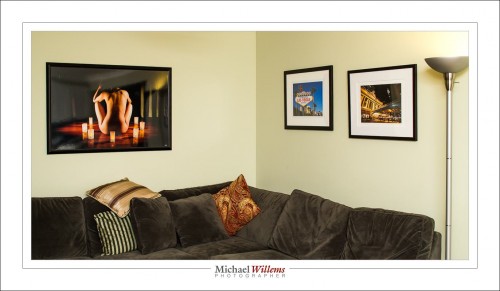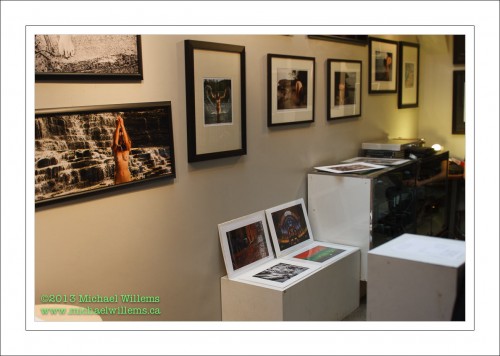As I have said, printing your images is a great idea. Here’s a few on my living room wall:
It is also complicated – that’s one reason prints cost real money – and time-consuming. But – worth it. Here’s a few decision points for you, when you consider printing.
What tool? I print straight from Lightroom. No intermedia file with colour spaces to worry about, no loss of tines, and great functionality. More about that in future (and past) posts.
When you print, the first question is: “how large”. The two prints on the right in the image above were made on 13×19″ paper, and framed. If you use that kind of size, you will want to hang multiple prints. The image on the left is approximately 40 by 24″. That is suitable for a wall all by itself. Prints up to 13×19″ can be made on a printer like the Canon 9500 MkII.
The second question concerns the printer. Dye or pigment? Most inkjet printers are dye printers. A few, like my 9500 MkII, are pigment printers. The difference? Basically, dyes combine with the paper they are printed on; pigments form a suspension on top of it. The reason to go for pigments is that they last longer and will not fade or shift colour. Dyes, although they are getting much better, will usually fade within 25 years. When I sell, or hang, a work of art, I want it to last for centuries – which pigments will do. If you want your prints to last as long as photo lab photos, pigment is the way to go.
Then, the type of paper. Matte or glossy? That is often a judgment call. Glossy is “like a photo”, matte is “like a painting”. Some photos work best on glossy, some on matte. This is where taste and experience and preference all come together. I recommend that like me you settle on maybe four types of paper; learn what they do; and stick to those.
If you want resistance to fading, use natural fibre paper (such as the Hahnemülle papers). These are not coated, so they are not as white as brightened papers – but brightened papers will lose their brightness.
You can also, of course, go for metallic (like the print on the left in the image above). This is wonderful, sharp, glossy, with a great silvery shine. In addition, metallic prints do not need glass, so they can use a very simple frame. You can even wipe them.
Then, the aspect ratio. No, no, no: your prints do not have to be 3:2 like they come out of the camera, or 8×10 because that’s the only frames you can find. make your prints any aspect ratio that please you. Even square, or long and thin like the print on the left here, from a gallery exhibit I did last year in The Distillery District on Toronto:
Finally, then the frame. A photo, like a painting, generally looks much better framed. Be warned that framing is not cheap – but it’s worth it. A custom frame, with a custom-cut mat, means your print can be any size. You frame according to the print’s needs. As a result, you will have a unique work that reflects your taste, environment and needs.
Do have a look at some of the pictures I am currently selling in limited editions, all handprinted and individually autographed: www.michaelsmuse.com. Interested? I ship worldwide.


